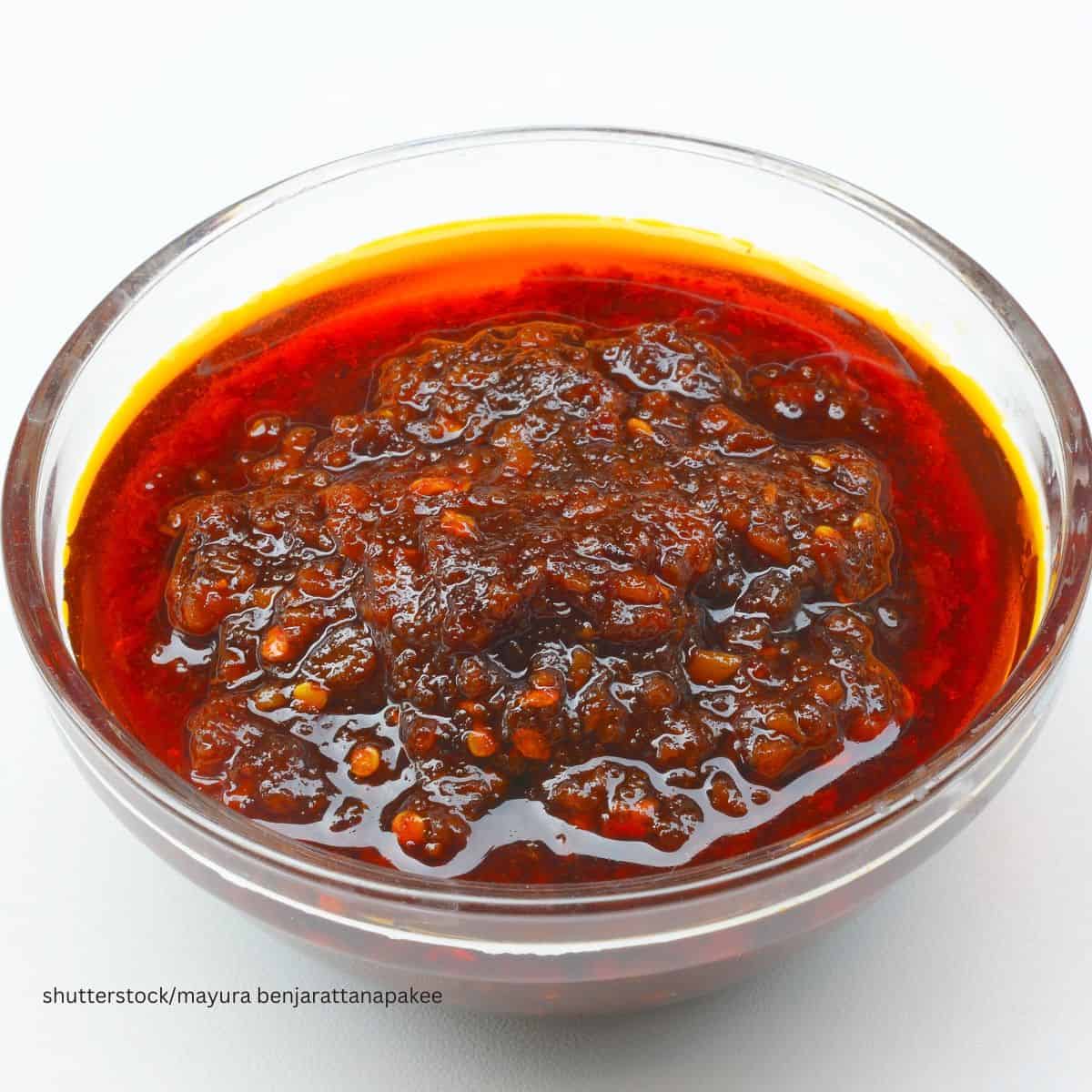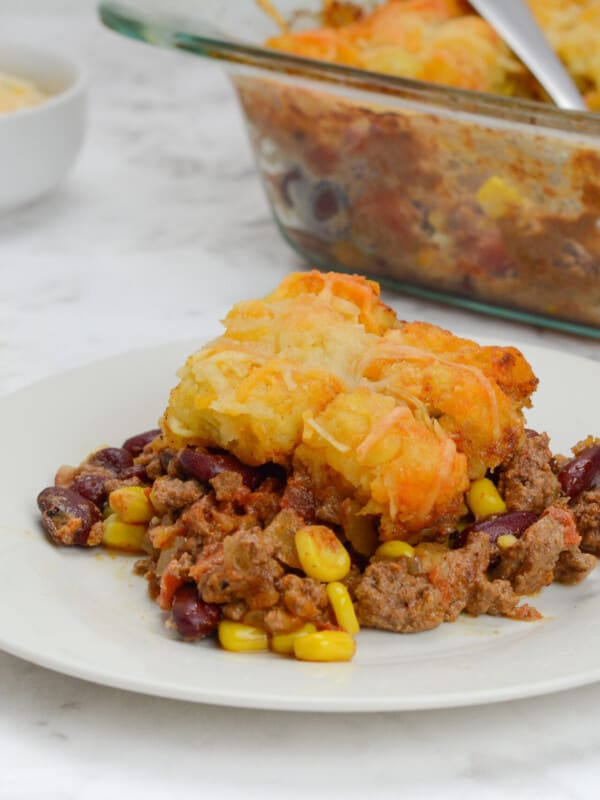Chili paste is a fantastic way to add both flavor and heat to your meals, with the delicate peppery taste well preserved along with the concentrated capsaicin in the peppers.
The thing is, between occasional hot pepper shortages, and the sheer heat and intensity of a lot of chili paste options, this ingredient isn’t always available, or the right choice for your home kitchen.
Here are some of the best chili paste substitutes you can use in your home.

We’ve looked for options that bring a similar flavor, but a range of different heat levels so you can find the right ingredient for any dish, and any level of spice tolerance.
| Substitute | Flavor Profile |
| Ketchup and Ground Cayenne Pepper | Sweet, acidic, and with varying levels of spice. |
| Ketchup and Crushed Red Pepper | Tends to be sweeter than ketchup and ground cayenne. Spice levels are variable, more muted acidity. |
| Crushed Red Pepper Flakes | Lots of spice, slightly sweet pepper flavor, ranges from subtle to overpowering depending on how much you add. |
| Sriracha | Complex peppery taste mixed with other aromatics like onion and garlic. |
| Franks Red Hot Hot Sauce | Tangy and vinegary with a strong heat – but available in a range of spice levels depending on your tolerance. |
| Louisiana-Style Hot Sauce | Variable, but usually strong vinegar, slight sweetness, and a lot of heat. |
| Sambal Oelek | Very spicy, slightly salty, with a sweet tang. |
| Harissa | Very spicy, sweet, with a strong red bell pepper flavor. |
| Red Curry Paste | Variable spice levels, but usually more aromatic than spicy. Common blends include cumin, coriander, cardamom, turmeric, and other spices. |
| Gochujang | Smokey pepper paste, usually very hot, but available in variable spice levels. Slightly oily. |
| Piri Piri Sauce | Sweeter than most alternatives, high spice levels, tangy, and a little salty. |
| Spicy Tomato Paste | Stronger tomato flavor, some spice, but not as much as most hot sauces, may also be flavored with herbs or aromatics. |
| Roasted Bell Pepper Paste | Sweet, slightly smokey, tangy, similar to fresh bell pepper, but more savory than the fresh vegetable. |
| Red Pepper Flakes And Hot Oil | Spicy, but more complex than red pepper flakes alone. |
| Canned Chipotle Peppers | Vinegar and spice, tangy, with a little sweetness and a lot of smoke. |
| Romesco Sauce | Tangy, bright, and bold, with strong tomato and red bell pepper flavors, less spice. |
Why Would You Want To Substitute Chili Paste?
There are a lot of reasons to potentially substitute chili paste. If you run out of chili paste when you need it, want to experiment with the same heat but a different flavor, or want to tone down the heat of a typical chili paste, you might want to reach for a replacement.
Replacements can also help you customize recipes that call for chili paste, creating something unique and entirely your own.
Knowing good replacements for chili paste can also help you customize the heat level of your meals for guests or family members, either increasing the heat or toning it down depending on their preferences.
The Best Chili Paste Substitutes And When To Use Them
Most of these replacements are going to add a slightly different flavor to a meal than chili paste. One of the nice things about a good chili paste is that the paste doesn’t add too many unexpected flavors. The flavor comes mostly from the chili peppers, with a mild oil working both to provide moisture and prevent oxidizing.
A lot of these alternatives are either vinegary or add another spice or aromatic flavor. That can be helpful for complexity or may mean you need to add something else to help balance the additional flavors.
It’s a good idea to experiment with different additions to find the ones you like best, depending on whether you want a similar flavor without the heat, the same heat and a similar flavor, or just the heat, and something different for the taste.
Ketchup and Ground Cayenne Pepper
This is probably the fastest and simplest make-at-home alternative to chili paste. You can easily customize the heat by changing the amount of cayenne powder you add. Add more for a smokier spicier flavor, less for a sweeter flavor with some kick.
The drawback is that ketchup is a very identifiable taste, so in recipes that don’t already call for ketchup, it can stand out.
Ketchup and Crushed Red Pepper
Ketchup and crushed red pepper can add a more complex and varied flavor than using ground cayenne, which tends to be more bitter and smokey, but with less pepper flavor.
However, this option takes longer. You either need to let it sit for a few hours for the pepper flavor to soak in, or you need to heat the red pepper flakes and ketchup to get the flavors to blend.
So, it’s a little more work, but the added depth of flavor is worth it.
Crushed Red Pepper Flakes (Or Any Pepper Flake Blend)
The easiest option if you have red pepper flakes in your home kitchen is just to add some of them to the meal.
Remember that you need to add red pepper flakes earlier than chili paste in cooking if you want the flavors to come out. For quick end-of-cooking adjustments, hot sauce or ground cayenne pepper will work better.
Sriracha
Sriracha might not be a traditional Asian sauce, but it’s inspired by things like classic chili and chili garlic paste and brings a lot of flavor in addition to the added spiciness.
This is a good option for meals that are feeling a little flat, for last-minute spice adjustments, and for really enhancing the Asian flavors of a meal.
Franks Red Hot Hot Sauce
Franks Red Hot is a good hot sauce alternative to chili paste, particularly for non-Asian cooking. However, in addition to the heat, it can add a lot of vinegar tang to your meals.
The good news is you don’t need much hot sauce to add the heat you’re looking for, and adding a minimum can help keep the vinegar flavor under control.
Louisiana-Style Hot Sauce
Louisiana-style hot sauces are a pretty good bet as a chili paste substitute. Just remember that the added vinegar in the hot sauce can be a powerful flavor.
If your recipe already calls for some vinegar, reduce the amount by about how much hot sauce you add. Or, you can add the hot sauce directly to the vinegar, to get the flavor fully infused throughout.
Sambal Oelek
A lot of people are actually thinking of Sambal Oelek when they think of chili sauce, and this is a specific kind of chili paste that doesn’t include any garlic or onion, unlike some brands.
It’s a spicy, but well-developed heat, with less bite than other alternatives.
This blend is specifically Indonesian, but it’s a good fit anywhere you want to add a lot of heat without having to use much of the sauce or worrying about too many additional flavors.
Harissa
Harissa is a Moroccan red pepper and chili paste that is a good alternative for a plain chili paste. Often spicier than other cooking chili pastes, you won’t need much of this to add brightness, sweetness, and a whole lot of heat to your cooking.
Harissa does add a pretty pronounced red bell pepper flavor and is often sweetened with sugar. You may need to adjust how much of any sweetener you add to your cooking if you use this. But, honey can help bring out the red pepper flavors while also mellowing the heat slightly.
Red Curry Paste
Red curry paste is a good alternative if you want to add some spice and complexity, but aren’t necessarily looking for the burning heat of a chili paste.
Remember that curry pastes are often complex blends of a lot of different spices, herbs, and aromatics, and have a very distinct flavor. Perfect for curries, Southeast Asian cooking, or meals that are similar to a curry, curry paste is a bit less flexible as a substitute compared with the other ingredients we’ve discussed.
Gochujang
Gochujang is a Korean chili paste, though the specific pepper used in gochujang is sometimes dried and sold as a spice.
The spice offers a good mixture of heat and smokey flavor but has less impact on your cooking than the paste.
The paste is less spicy, more savory, and has a complex slightly sweet flavor similar to miso. That’s thanks to a fermentation process that means that this sauce adds a ton of complexity and depth of flavor to any meal.
Piri Piri Sauce
Piri piri, sometimes called peri peri, is an African sauce made with chili peppers, specifically the very spicy bird’s eye pepper.
This sauce can be used as a cooking sauce on its own, or as an addition to bring out other flavors in your cooking. Piri piri ranges from very spicy, to mild with a sweet and tangy kick. The exact aromatics and other ingredients vary quite a bit though, so it’s best to make your own or stick to a specific brand if you want to use piri piri as a chili paste substitute.
Spicy Tomato Paste
For a milder and easy alternative, you can add some regular spicy tomato paste from a jar. Even spicy tomato sauces work pretty well, as long as you take the other flavors into account.
Since tomato pastes are also concentrated, this is a 1:1 substitution. Just add as much tomato paste as you would normally add chili paste, and then adjust from there.
Roasted Bell Pepper Paste
For a very mild replacement you can make your own roasted red bell pepper paste. Either buy storebought peppers, which come in an oil and vinegar sauce you can use blending together for a paste, or buy several bell peppers, roast them on the broil setting, and make your own sauce.
This is sweet, savory, tangy, and a little smokey, but without the heat.
Red Pepper Flakes And Hot Oil
Hot oil can bring out the best flavors in red pepper flakes. Just heat the oil, measure out the red pepper flakes you want into a heat-proof container, and then pour the oil over the flakes. Let the oil sit for at least 5 minutes before adding to any meal.
Canned Chipotle Peppers
Canned chipotle peppers are a good substitute for chili paste that bring a little more flavor to the table. Replace 1:1 for a slightly milder but more flavorful addition, add more for more heat and flavor, or less for a milder replacement.
Romesco Sauce
Lastly, Romesco sauce is delicious enough to be eaten on its own, but it has a lot of the advantages and benefits of chili paste when added to another dish.
A small amount of this sauce will add a little bit of heat but adds more bell pepper and sundried tomato flavor. More sauce will add more of those flavors, as well as a little more heat. However, not as much as other options.
Final Thoughts
Chili paste is a versatile and effective ingredient, but these substitutes all have their own advantages as well. Even when you do have chili paste on hand, you might want to experiment with some of these alternatives to see if you prefer the flavor!





